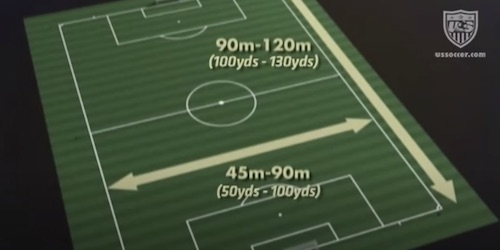What are the dimensions of a soccer field? Here’s a run down of the dimensions of all the different areas of a soccer pitch, from the penalty box to the corner area. All soccer fields should have the same dimensions, or at least be very close in size. While there can be some variations in the width and length of soccer field, the standard measurements are listed below. If you want to learn more about the soccer field dimensions and regulations you can also watch the video below. Image credit to Ken Aston Referee Society.
Soccer Field Dimensions
Soccer Pitch the length of the soccer pitch can be between 90 and 120 meters (100-131 yards), and the width can be between 45 and 90 meters (49-100 yards).
Corner Area 1 yard space where the player can move the ball around in when taking a corner kick
Penalty Box (18 yard box) space where the goalie can touch the soccer ball with their hands and if a player is fouled in this area results in a penalty kick
Goal Box (6 yard box) smaller box inside the penalty box, where the goal places the ball for a goal kick
Center Circle A ten yard area on each side of the half line, where soccer players must stay out of when the ball is kicked off at the beginning of the game
Goal Size 24 feet wide and 8 feet high
Penalty Spot 12 yards from the goal; where penalties are taken
Goal Line the end lines of the soccer field where the ball can go out for a corner kick or a goal kick
Soccer Field Dimensions Visual
Soccer Field Pitch Dimensions and Size that you should know about: https://t.co/RZ4NlUm4Jd pic.twitter.com/npXtt45P4v
— CoachesTrainingRoom⚽ (@CoachesTrngRoom) September 3, 2016
Here’s a video talking about the dimensions of a soccer pitch from FIFA:
Soccer matches may be played on natural or artificial surfaces, according to the rules of the competition.
The color of artificial surfaces must be… green. (Thankfully this is a requirement otherwise you’d see lower level clubs trying to get attention buy changing the color of the turf!)
Where artificial surfaces are used in either competition matches between representative teams of member associations affiliated to FIFA or international club competition matches, the surface must meet the requirements of the FIFA Quality Concept for Football Turf or the International Artificial Turf Standard, unless special dispensation is given by FIFA.
Soccer Field Markings…
The field of play must be rectangular and marked with lines. These lines belong to the areas of which they are boundaries.
The two longer boundary lines are called touch lines. The two shorter lines are called goal lines.
The field of play is divided into two halves by a halfway line, which joins the midpoints of the two touch lines.
The center mark is indicated at the midpoint of the halfway line. A circle with a radius of 9.15 m (10 yds) is marked around it.
Marks may be made off the field of play, 9.15 m (10 yds) from the corner arc and at right angles to the goal lines and the touch lines, to ensure that defending players retreat this distance when a corner kick is being taken.
Soccer Field Dimensions continued…
The length of the touch line must be greater than the length of the goal line.
Length: (touch line): minimum 90 m (100 yds) maximum 120 m (130 yds)
Width: (goal line): minimum 45 m (50 yds) maximum 90 m (100 yds)
All lines must be of the same width, which must be not more than 12 cm (5 ins).
International Soccer Matches…
Length: minimum 100 m (110 yds)maximum 110 m (120 yds)
Width: minimum 64 m (70 yds) maximum 75 m (80 yds)
The Goal Area…
Two lines are drawn at right angles to the goal line, 5.5 m (6 yds)from the inside of each goalpost.
These lines extend into the field of play for a distance of 5.5 m (6 yds) and are joined by a line drawn parallel with the goal line. The area bounded by these lines and the goal line is the goal area.
The Penalty Area…
Two lines are drawn at right angles to the goal line, 16.5 m (18 yds) from the inside of each goalpost.
These lines extend into the field of play for a distance of 16.5 m (18 yds) and are joined by a line drawn parallel with the goal line.
The area bounded by these lines and the goal line is the penalty area.
Within each penalty area, a penalty mark is made 11 m (12 yds) from the midpoint between the
goalposts and equidistant to them.
An arc of a circle with a radius of 9.15 m (10 yds) from the centre of each penalty mark is drawn outside the penalty area.
Flag posts…
A flag post, not less than 1.5 m (5 ft) high, with a non-pointed top and a flag must be placed at each corner.
Flag posts may also be placed at each end of the halfway line, not less than 1 m (1 yd) outside the touch line.
The Corner Arc…
A quarter circle with a radius of 1 m (1 yd) from each corner flag post is drawn inside the field of play.
Goals…
A goal must be placed on the center of each goal line.
A goal consists of two upright posts equidistant from the corner flag posts and joined at the top by a horizontal crossbar.
The goalposts and crossbar must be made of wood, metal or other approved material.
They must be square, rectangular, round or elliptical in shape and must not be dangerous to players.
The distance between the posts is 7.32 m (8 yds) and the distance from the lower edge of the crossbar to the ground is 2.44 m (8 ft).
Safety…
Goals must be anchored securely to the ground. Portable goals may only be used if they satisfy this requirement.
FREE Soccer Training Tips from Coerver Coaching: Enter your email address at this link to start your free soccer training tips: Six Steps to Soccer Success. Find Out Why Over 70,158 Coaches Love Coerver Coaching. Learn more about the The Coerver Coaching Method.















